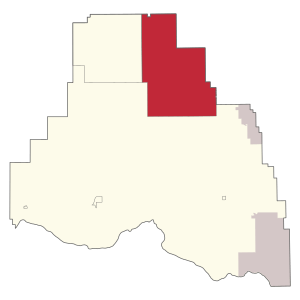Kikino Metis Settlement facts for kids
Quick facts for kids
Kikino Metis Settlement
|
|
|---|---|
|
Metis Settlement
|
|

Location within Smoky Lake County
|
|
| Country | Canada |
| Province | Alberta |
| Region | Central Alberta |
| Census division | 12 |
| Area
(2021)
|
|
| • Land | 799.78 km2 (308.80 sq mi) |
| Population
(2021)
|
|
| • Total | 387 |
| • Density | 0.5/km2 (1/sq mi) |
| Time zone | UTC−7 (MST) |
| • Summer (DST) | UTC−6 (MDT) |
The Kikino Metis Settlement is a special community in central Alberta, Canada. It is one of eight Metis Settlements in the province. The settlement is located in Smoky Lake County, along Highway 36. It's about 128 kilometers (80 miles) west of Cold Lake.
Kikino is the smallest community within the larger Metis Settlement area. It covers about 44,000 hectares (108,726 acres) of land. The closest large body of water is Cold Lake, Alberta. Like other Metis Settlements, Kikino acts like its own town. It has its own schools, a post office, and other important buildings. The land here provides resources like natural gas, oil, and opportunities for fishing.
Contents
Who Lives in Kikino?
In 2021, about 978 people lived in the Kikino Metis Settlement. These people lived in 309 homes. This number was a bit higher than in 2016, when 934 people lived there. The population usually stays under 1,000 people.
In 2018, a local count showed 928 people living in Kikino. This was a small increase from 918 people in 2015.
A Look at Kikino's Past
In the beginning, the people of Kikino were part of a larger group of Metis First Peoples. They lived in the Great Lakes region. As European settlements grew, the Metis moved north to where they are now. At first, there were two main Metis groups: French Metis and Anglo Metis. Over time, these groups formed twelve communities, which later became eight. Kikino is one of those eight communities.
Early Land Laws
A big law that affected Kikino was the Dominion Lands Act of 1872. This law made land in Western Canada very cheap for new settlers. However, it did not include the Metis people until the late 1870s.
Creating the Metis Settlement
The Kikino Metis Settlement was officially created by the Métis Population Betterment Act in 1938. The government of Alberta passed this law. It was created because the Metis people were living in difficult conditions. They were already living on the land, but they did not have control over it.
This act allowed the Metis Settlement to form its own government. The goal was to improve living conditions for the Metis First Peoples. It also helped them keep their culture and traditions alive. The Betterment Act did not give the Metis complete control over their land, but it gave them more rights than before.
From Goodfish Lake to Kikino
The Metis Population Betterment Act first set up 12 Metis colonies. Kikino was known as Goodfish Lake back then. Later, the community chose the name Kikino, which means "our home." This new name showed what the Betterment Act meant to them. It gave them a fresh start and a place they could truly call their own.
The Betterment Act was reviewed again later. In 1952, the Metis people were allowed to elect their own leaders. They also gained control over their businesses. By 1960, only 8 of the original 12 communities remained part of the Metis Settlement. Kikino was one of them.
Community Events
Silver Birch Rodeo & Celebration Days
The Silver Birch Rodeo is a popular yearly event in Kikino. It happens during the community's Celebration Days, usually in August. The event lasts for two or three days. It features exciting rodeo activities like bull riding, cow riding, and wild horse racing. This rodeo is becoming very popular and might need a bigger space in the future! Kikino also hosts other fun events, such as the Slo-Pitch Tourney and the Metis Triathlon.
Kikino's Culture and Traditions
Kikino's culture is a mix of First Nation traditions and European influences. The Metis Settlements fought for their own land and government rights. This was because they faced challenges in adapting to Western ways of life. The Metis people have always been closely linked to Canadian history.
Languages Spoken
Most people in the Kikino settlement speak English. However, many also speak their "mother tongue" languages. These include Aboriginal languages like Cree, Northern Athabaskan languages, and Dene. Michif, a unique language that blends Cree and French, is also spoken in Kikino.
Unique Architecture
Kikino is known for its buildings and architecture. These buildings play a big part in the community's identity. Symbols like the Metis flag and birchbark canoes are important in Kikino traditions.
When Metis families first gained rights to their land, they built homes using materials they could find easily. This often meant using logs or thick pieces of wood. Building homes this way kept the traditions of their ancestors alive. They reused many resources, which helped them stay connected to their heritage. The elementary school in Kikino is a great example of Metis traditions and building styles. The community often works together to share new building skills and ideas.


